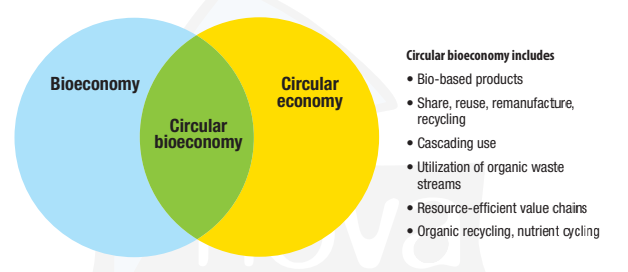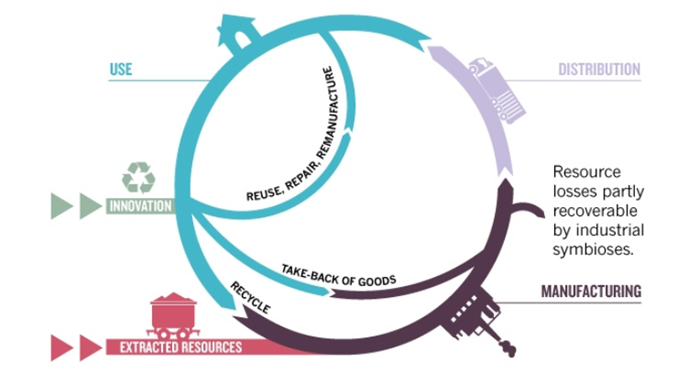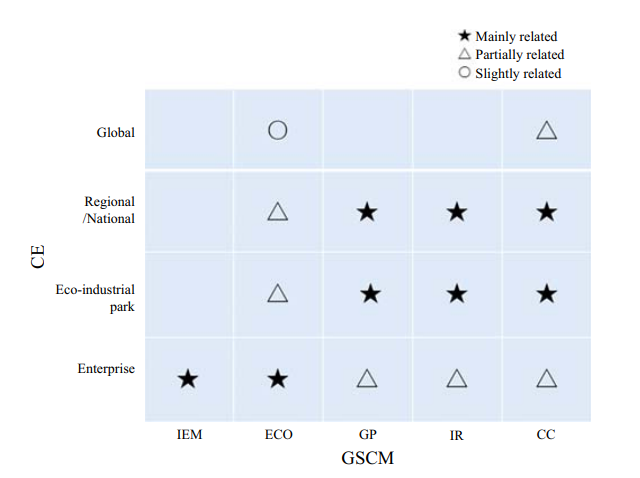Circular economy assignment: Supply Chain Management in Royal Dutch Shell
Question
Task:
You are required to discuss how companies that adopt circular economy principles increase their economic and social efficiency and minimise their environmental impact.
More specifically, you are required to write a report that provides two perspectives of the topic above: A theoretical and a practical perspective. The report as a whole should be no longer than 3000 words (excluding cover page and references).
Answer
1. Organization background
1.1 Description of the Company selected in the circular economy assignment
"Royal Dutch Shell" is a British based oil and gas company that has revenue growth of $388.37bn. It has increased by 22.76% in 2018 and has its wings all over the first world countries (www.shell.com, 2020). They aim to provide fuel with low carbon content so that they contribute to the green a clean environment (www.shell.com, 2020). They always maintain a fixed revenue rate by implementing effective strategies on the system.
1.2 Product/Services by the Company
The main products/ services of the “Royal Dutch Shell” company are to provide oil and gas products with less carbon content. It will help them in contributing to the cleaner and greener environment (www.shell.com, 2020). They have an integrated supply chain technology that helps to deliver the products within the specified time.
1.3 Initial Customers of the Company
The initial customers of the Company are owners of automobile industries and the distributors related to oil retailing (www.shell.com, 2020). In the oil and gas sector, there is a huge chance of getting potential customers that contribute great value to the system.
Explanation of the characteristics and concepts of “Circular Economy”
2.1 Discussion of concepts in “Circular Economy”
The concept of “Circular Economy” consists of four parts. The concepts can be modified according to the trend. Carus & Dammer (2018), states that there are many modifications has been made in the concepts. There are four concepts listed below within the circular economy assignment: -
a. Industrial Ecology- The flow of nature is cyclical that means the organization's operations are interrelated. The operations and department of the organization have a distinguished role and that needs to be executed within a specified time. It helps in maintaining a proper ecology on the system (Carus & Dammer, 2018). The concept of “Industrial Ecology” means that maintaining an ecological balance in the industry and make effective improvement on the system.
b. Industrial Symbiosis- The concept of “Industrial Symbiosis” involves the use of theories that are related to businesses and other actors of society. The theme is used to manage all the factors of the organization under one system (Korhonen, et al., 2018). It helps in maintaining collaboration with the other factors of society.
c. Cradle-to-Cradle Design- The concept of “cradle-to-cradle design” involves all the value chain operations in the organization. The product life cycle is also maintained by this concept of the circular economy presented in the circular economy assignment (Murray, et al., 2017). It uses fruitful sources from the organization environment and uses it on building the internal system of the Company.
d. Sharing Economy- The concept of “Sharing Economy” is an essential part of the "Circular Economy". It integrates the production system with the consumption system. It also promotes the "shared-use" of physical services in a working environment. Carus & Dammer (2018), argues that the use of shared services enhances the organization’s economy. It also helps in building the bond within the organization.
2.2 Discussion of characteristics in “Circular Economy”
The essential characteristics of “Circular Economy” include upgrading the purpose of CE on the organization. The upgraded model of “Circular Economy” is listed below within this circular economy assignment: -
a. Bioeconomy- The concept of "Bioeconomy" is related to recycling fossil fuel and the waste generated from industries. Mainly the oil and gas or plastic industries generate a heavy amount of waste on the air. Thus, they need to follow this concept. It will help them to recycle their waste and developing a green environment. It must be noted Government have already imposed some rules on the waste recycling (Korhonen, et al., 2018). The organization is maintaining that rule properly. They have modified their policies so that waste can be controlled without affecting the production and supply chain management.

Figure:- Diagram showing the relation between Bioeconomy and Circular Economy (Carus & Dammer, 2018).
b. “Cascading use” of “Circular Economy”- The "cascading use" is a traditional concept before the invention of "Circular Economy". It includes remanufacturing of the products and improves the company's growth. It helps in enhancing the delivery process of the supply chain sector related to the industry. In the oil and gas industry, it has been observed that the re-use of fossil fuel (which are considered as waste) helps as the booster for supply chain process. They can be used for the backup on the delivery process to the customers (Korhonen, et al., 2018). "Cascading use" helps in reducing the fossil carbon demand over the world. As the fuel is getting re-used, thus the waste generation rate along with consumption rate is getting reduced.
3. Discussing the drivers of “Circular Economy”
3.1 Importance of drivers on organization
The drivers have great importance in the organization. It helps in improving the operations of the Company. The drivers are listed in the following section of circular economy assignment: -
a. Resource scarcity- Resource scarcity can affect the organization negatively. It results in building uncertainties in the organization (Agyemang, et al., 2019). The supply chain management also gets affected by this scarcity. If the raw materials are not in stock, then the delivery process also gets affected.
b. Environmental Degradation- Environmental degradation leads to major turbulence in the system (Govindan & Hasanagic, 2018). Especially the oil and gas sector get affected by natural disaster as their production gets shut down during this situation. It results in a huge loss of the company.
c. Positive business opportunities- Business opportunities help leaders to expand their business. Expansion of business needs improvement in the supply chain management so that the customer gets fully satisfied with the in-time delivery process (Hart, et al., 2019). The system must be integrated so that the monitoring of the supply chain management can be done effectively.
d. Consumer pressure- Consumer pressure involves an improved method of supply chain management and its effectiveness on the circular economy. The company can develop new products if the consumer demands and pressurize for it (Ranta, et al., 2018). The supply chain management thus needs to be improved so that the customer demand can be met.
e. Improved firm performance- Improvement in firm performance helps in bringing potential customers to the business. It brings positive feedback for the company from the customer (Ranta, et al., 2018). The company can expand and improve effectiveness.
3.2 Discussion of the social, economic and environmental benefits
The drivers have a great effect on the organization. It is referred to as the main factors of the circular economy and helps in enhancing the operations of the company. The drivers result in great benefits respect to social, economic and environmental. Thus, it needs to discussed briefly in this context.
a. Social benefits- Circular Economy helps in reducing the rate of unemployment and provide better opportunities to people. The companies can sell their products by creating interactive designs through recycling the wastes (Adams, et al., 2017). New jobs can be created on the oil and gas sector as new business opportunities by recycling the waste.

Figure:- Diagram showing the interrelationship between various aspects of society with a circular economy (Stahel, 2016).
b. Economic benefits- As mentioned in the circular economy assignment the finance can be enhanced through the implementation of the circular economy on the organization. It helps the leaders to take financial decisions easily (Kumar, et al., 2019). Recycling waste creates new business opportunities and helps in developing revenue growth. The growth is measured annually and the effects of the circular economy on it.
c. The environmental benefits- The circular economy has a great environmental benefit as it involves recycling the wastes generated from the company. Especially, in the oil and gas sector, harmful waste is generated that fell a great effect on the environment (Junnila, et al., 2018). It fell an indirect impact on supply chain management because modifying the operations leads to improvement in the delivery process. The organization can satisfy their customer needs effectively.

Figure:Environmental effect on Corporations and Entrepreneurs (Veleva & Bodkin, 2018).
4. Support of circular “supply chain” in “Circular economy” processes
The supply chain process helps to enhance the “Circular Economy” and vice versa. The relation can be determined by studying the benefits and drivers of the “Circular Economy”. In the oil and gas sector, the "Circular Economy" processes need great support from the "Supply Chain Management". Delay in delivery leads to loss of the Company. Thus, it needs more strategies to improve the “Circular Economy” processes by implementing sustainable theories of “Supply Chain management”. “Resource dependence theory” builds the linkage between “supply chain” and “Circular Economy”. It helps in improving the “Circular Economy” by enhancing the “Supply chain” processes within the organization.

Figure:- Diagram showing the linkage factor between “Green Supply Chain Management” and “Circular Economy” (Liu, et al., 2018).
5. Role of “Circular Economy” to create job
The main social role of the "Circular Economy" is to create a job for job seekers by developing new business opportunities. The business opportunities are created by remanufacturing or recycling the waste generated by the Company (Hart, et al., 2019). It will help in reducing the unemployment rate and contribute a positive effect on the country. The GDP rate can also be increased by creating new job opportunities and recruiting people in bulk. Marketing options will also get increased by recycling the products and recruiting effective marketing persons in the company.
6. What is the application of concepts discussed in the circular economy assignment?
6.1 6.1 Description of Company’s “business model” for discussing the “circular economy”
6.1.1 Operations department
“Royal Dutch Shell” has an effective operations department as they believe in teamwork services. They make unique products related to fuel for satisfying the demands of customers. They have a big network because they are in this sector since 1907. The efficient performance from the operations management has helped them to increase their products and network in the international market. They are earning a huge amount of profit from their product. The operations team always focuses on improving the business model of the Company. It helps in engaging potential customers as well as investors in the Company.
6.1.2 Supply Chain department
The work of the “Supply Chain” is to deliver the products within the specified time. It helps in gathering the positive feedback from the customers. "Royal Dutch Shell" has an integrated business model that helps in managing all the functions including the supply chain through effective strategies. The strategies help in building an efficient business model for the future. Leaders on the company always focus on developing strategies that are beneficiary for the “supply chain” management. It helps in engaging new customers on the Company.
The business model case for “Royal Dutch Shell” has been explained on the table below within the circular economy assignment.
|
Business Model |
|||
|
Sales |
Marketing |
Production |
Supply chain |
|
Sales mainly focus on increasing the selling value of the product along with follow-up the customers on buying the product |
Marketing is mainly related to promotion in the "Royal Dutch Shell" (www.shell.com, 2020). They promote products to engage customers on the Company. Moreover, it also helps in widening their network. |
the production team is mainly focused on manufacturing the product for customers (Gligor, et al., 2019). They share the product configuration with sales so that they can sell the product effectively. |
The supply chain mainly includes the delivery process of the product. It is one of the essential parts of the Company (Gligor, et al., 2019). As it helps in bringing positive feedback for the Company. The satisfaction of the customer results in producing positive feedback (Gligor, et al., 2019). The financial growth of the “Royal Dutch Shell” is also dependent on "supply chain management". |
6.2 Discussion of the social, environmental and economic benefits
6.2.1 Social benefits
The family of "Royal Dutch Shell" have got increased and building an economical product through shared services. The Company recruits a huge number of employees annually to produce and sell their products on the market. It fell an overall effect on the country’s economy. The Company has made them successful through the use of circular economy on their organization. As they focus on developing creative products for contributing to the greener environment. They always look for creative minds that can build new and innovative products on the market. The Company has a target-based focus and try to meet their annual target. As per the data taken from the Company's website, the revenue of the company increased by 22.76% (www.shell.com, 2020). The employee number is also increasing along with an increase in the revenue.
6.2.2 Environmental benefits
Creation of new products has contributed to a greener and cleaner environment. Thus, the company has a great environmental benefit on the ecology. "Royal Dutch Shell” aims to build such products that are both beneficial and effective for the environment (Agyemang, et al., 2019). The customer needs are also maintained as the product is being modified for providing great performance to them. The customer thus provides positive feedback on the product (Adams, et al., 2017). The company examined in the segments of circular economy assignment also focuses on implementing the feedback on the product and modify it according to the customer’s demands.
6.2.3 Economic benefits
The ‘circular economy’ is gaining momentum as a concept in both academic and policy circles, while circular business models have been linked to significant economic benefits (Junnila, et al., 2018). While the capacities of larger firms facilitate the adoption of and realization of benefits from circular business models. It helps in making the growth of the economy on the organization.
7. Bibliography
Adams, K. T., Osmani, M., Thorpe, T. & Thornback, J., 2017. Circular economy in construction: current awareness, challenges and enablers. s.l., circular economy assignment Thomas Telford Ltd, pp. 15-24.
Agyemang, M. et al., 2019. Drivers and barriers to circular economy implementation. Management Decision.
Carus, M. & Dammer, L., 2018. The circular bioeconomy—concepts, opportunities, and limitations. Industrial biotechnology, 14(2), pp. 83-91.
Gligor, D., Bozkurt, S., Russo, I. & Omar, A., 2019. A look into the past and future: theories within supply chain management, marketing and management. Supply Chain Management: An International Journal.
Govindan, K. & Hasanagic, M., 2018. A systematic review on drivers, barriers, and practices towards circular economy: a supply chain perspective. International Journal of Production Research, 56(1-2), pp. 278-311.
Hart, J. et al., 2019. Barriers and drivers in a circular economy: the case of the built environment. Procedia Cirp, Volume 80, pp. 619-624.
Junnila, S., Ottelin, J. & Leinikka, L., 2018. Influence of reduced ownership on the environmental benefits of the circular economy. Sustainability, 10(11), p. 4077.
Korhonen, J., Honkasalo, A. & Seppälä, J., 2018. Circular economy: the concept and its limitations. Ecological economics, Volume 143, pp. 37-46.
Korhonen, J., Nuur, C., Feldmann, A. & Birkie, S. E., 2018. Circular economy as an essentially contested concept. Journal of Cleaner Production, Volume 175, pp. 544-552.
Kumar, V. et al., 2019. Circular economy in the manufacturing sector: benefits, opportunities and barriers. Management Decision.
Liu, J., Feng, Y., Zhu, Q. & Sarkis, J., 2018. Green supply chain management and the circular economy. International Journal of Physical Distribution & Logistics Management.
Murray, A., Skene, K. & Haynes, K., 2017. The circular economy: an interdisciplinary exploration of the concept and application in a global context. Journal of business ethics, 140(3), pp. 369-380.
Ranta, V., Aarikka-Stenroos, L., Ritala, P. & Mäkinen, S. J., 2018. Exploring institutional drivers and barriers of the circular economy: A cross-regional comparison of China, the US, and Europe. Resources, Conservation and Recycling, Volume 135, pp. 70-82.
Stahel, W. R., 2016. The circular economy. Nature, 531(7595), pp. 435-438.
Veleva, V. & Bodkin, G., 2018. Corporate-entrepreneur collaborations to advance a circular economy. Circular economy assignment Journal of Cleaner Production, Volume 188, pp. 20-37.
www.shell.com, 2020. WHO WE ARE. [Online] Available at: https://www.shell.com/about-us/who-we-are.html#:~:text=Shell%20is%20an%20international%20energy,manufacturing%20and%20marketing%20of%20chemicals.&text=Royal%20Dutch%20Shell%20was%20formed,half%20of%20the%2019th%20century.
[Accessed 19 August 2020].












